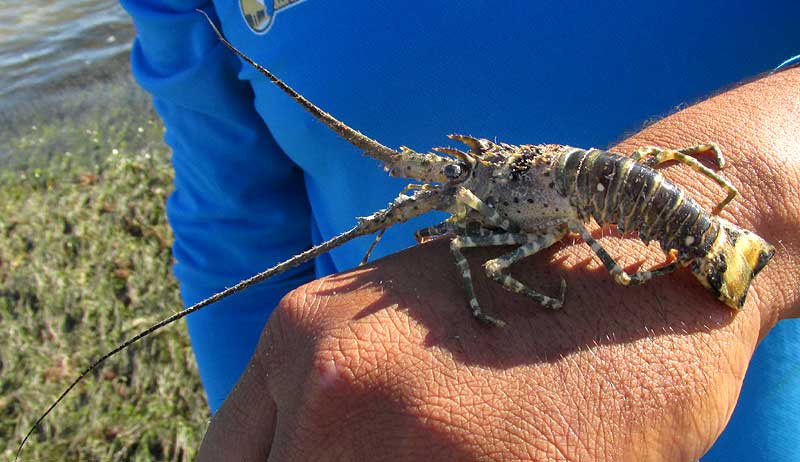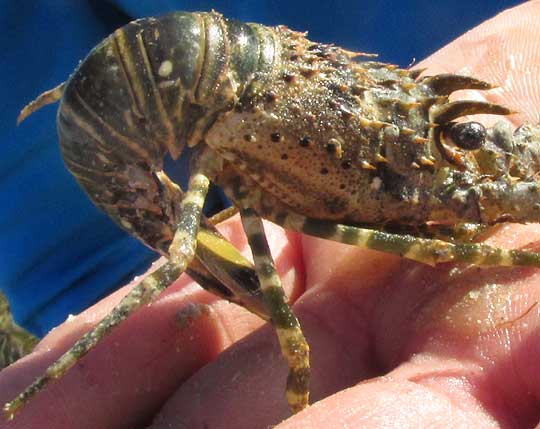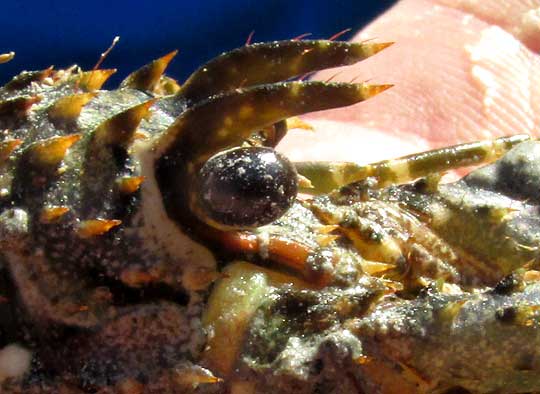Excerpts from Jim Conrad's
Naturalist Newsletter

from the March 15, 2015 Newsletter issued from Río Lagartos, on the Yucatan Peninsula's northern coast (~N21.60°, ~W88.16°), Yucatán state, MÉXICO
CARIBBEAN SPINY LOBSTER
At low tide Rayo and I were exploring in and around an old, metal, decaying dredging pipe left over from when the canal in front of Río Lagartos was dug. From inside an open-topped part of the pipe, Rayo plucked from the water the crayfish-like creature shown on his wrist above.
Rayo was excited because lobster fishing is big business around here, but normally you see them much larger than this one, and in much deeper water beyond the estuary, out in the Gulf of Mexico. Rayo assumed he was seeing a juvenile of that species, and learning that young ones live in the estuary. Soon the lobster curled into a shrimp-like pose, shown below:

A close-up of the creature's oval eyes and the forward-projecting spines around them is shown below:

You might guess that many kinds of lobster exist, if only because you know that lobsters eaten in restaurants up north bear big claws, while the one on Rayo's wrist doesn't. Taxonomically, big-clawed ones belong to the Lobster Family, the Nephropidae, while Rayo's is a member of the Spiny Lobster Family, the Palinuridae. So, technically, Rayo's lobster isn't a lobster; it's a SPINY lobster. The Spiny Lobster Family embraces about 60 species worldwide, and are recognized by being shaped like crawfish, bearing no big claws, and by having very long antennae armored with low spines.
Sipse.Com reports that during the 2014-2015 lobster season, 395 metric tons (435 US short tons) of spiny lobster were harvested in the waters off Yucatán State. This is reported, in Spanish, here.
The lobster species the Yucatan's fishermen catch is Panulirus argus, known as the Caribbean Spiny Lobster. You can see what that looks like on its Wikipedia page at https://en.wikipedia.org/wiki/Panulirus_argus.
When I compared Rayo's spiny lobster with pictures of Caribbean Spiny Lobsters, there were mismatches. For one thing, Caribbean Spiny Lobster tails display a different arrangement of spotting from ours. More strikingly, Caribbean Spiny Lobster legs bear long, narrow, dark lines on tan backgrounds, while our spiny lobster's legs bore broad bands and blotches.
It turns out that only 99% of the Yucatan's spiny-lobster catch consists of Caribbean Spiny Lobsters. 1% of the catch consists of a species called Rayo plucked from the decaying dredging pipe, which appears to be the Smoothtail Spiny Lobster, PANULIRUS LAEVICAUDA*.
*UPDATE: In 2024, with many more identification possibilities on the Internet, in reviewing this page, I find that just by looking I can't with certainty distinguish the Panulirus argus from the one much more encountered in the Yucatan, Panulirus argus. I read that the two species coexist in the Yucatan's waters.
However, SealifeBase.se says that P. laevicauda requires a rock or coral substrate, which our lobster didn't have. In contrast, P. argus "... inhabits shallow waters and found among rocks, on reefs, eelgrass beds or in any habitat that provides protection." Our lobster was in a well protected place beside a large Turtlegrass bed, which may be close enough. Therefore, now I'm suppossing that we have the Caribbean Spiny Lobster, PANULIRUS ARGUS.